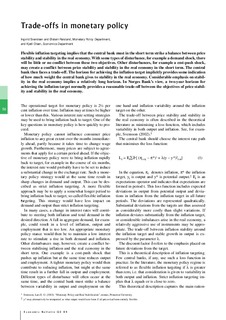| dc.contributor.author | Svendsen, Ingvild | |
| dc.contributor.author | Røisland, Øistein | |
| dc.contributor.author | Olsen, Kjetil | |
| dc.date.accessioned | 2018-07-05T07:45:16Z | |
| dc.date.available | 2018-07-05T07:45:16Z | |
| dc.date.issued | 2004 | |
| dc.identifier.issn | 0029-1676 | |
| dc.identifier.uri | http://hdl.handle.net/11250/2504447 | |
| dc.description.abstract | Flexible inflation targeting implies that the central bank must in the short term strike a balance between price stability and stability in the real economy. With some types of disturbance, for example a demand shock, there will be little or no conflict between these two objectives. Other disturbances, for example a cost-push shock, may create a conflict between price stability and stability in the real economy in the short term. The central bank then faces a trade-off. The horizon for achieving the inflation target implicitly provides some indication of how much weight the central bank gives to stability in the real economy. Considerable emphasis on stability in the real economy implies a relatively long horizon. In Norges Bank’s view, a two-year horizon for achieving the inflation target normally provides a reasonable trade-off between the objectives of price stability and stability in the real economy. | nb_NO |
| dc.language.iso | eng | nb_NO |
| dc.publisher | Norges Bank | nb_NO |
| dc.rights | Attribution-NonCommercial-NoDerivatives 4.0 Internasjonal | * |
| dc.rights.uri | http://creativecommons.org/licenses/by-nc-nd/4.0/deed.no | * |
| dc.title | Trade-Offs in Monetary Policy | nb_NO |
| dc.type | Journal article | nb_NO |
| dc.subject.nsi | VDP::Samfunnsvitenskap: 200::Økonomi: 210::Samfunnsøkonomi: 212 | nb_NO |
| dc.source.pagenumber | 56-57 | nb_NO |
| dc.source.journal | Economic Bulletin | nb_NO |
| dc.source.issue | 2/2004 | nb_NO |

